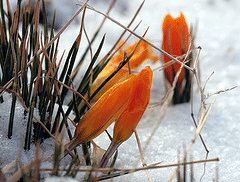Bulb, corms, rhizomes, tubers......
Nothing announces spring in the Midwest quite like spring flowering bulbs bursting through the last remnants of snow.
Bulbs can create stunning statements when planted in drifts or masses in a single color or a single type, but can also create interesting affects when scattered or clustered in and among other plantings. Bulbs of varying bloom times can easily fill voids in your flower beds between perennial blooming periods. They can also perk up plantings of deciduous shrubs before the leaves unfurl in spring. Or if you have a color themed garden, bulbs of the same color can be used to extend the effect. My blue and white garden includes early, mid and late season perennials and annuals, but the season opens with early blooming blue and white crocus, then blue muscari. Later, blue iris join the blue and white choir just before the perennials begin blooming.
The term bulb is somewhat loosely applied to not only “true” bulbs, but also corms, tubers, rhizomes and tuberous root plants. All of these are underground storage vessels for the energy and nutrients required to complete the life cycle of the plant. At the end of each bloom season new energy is created by the photosynthesis of the plants foliage and stored once again in the bulb for next season. The foliage must be allowed to die back to complete the cycle, and then may be cut back to the ground.
A “true” bulb is onion like with a papery covering protecting the developing plant. If cut open, layers of plant materials can be seen like a cut open onion. Daffodils, muscari (hyacinths) and tulips are some of the true bulbs. A lily has a bulb that is not protected by the papery covering so it needs to be kept moist if exposed.
Corms develop as a simple swollen mass at the stem base with no storage layers. The corms multiply and can be divided to form new plants, and the original corm will shrivel as the plant uses up the nutrients. The smallest corms may take a few seasons to develop a flowering size plant. Crocus and gladiolus grow from corms.
Tubers are an enlarged stem like a potato, which is scattered with buds, each bud developing plant shoots with roots. Anemone, begonias and caladium are tubers, as is the potato.
Tuberous roots store nutrients in the roots rather than an enlarged stem, causing the roots to be largely swollen. Dahlia grows from a tuberous root.
Rhizomes are stems that grow horizontally underground and spread sometimes rapidly. Ginger is a good example of a rhizome and appears very similar to iris, canna and calla lily rhizomes. Some rhizomes appear to be more like fleshy roots and may spread very rapidly, such as lily of the valley.
Plants with fleshy roots are sometimes grouped in the general bulb category. All the nutrients are stored in the fleshy roots. Daylilies and peonies are examples, but the daylily has an almost rhizome like root.




